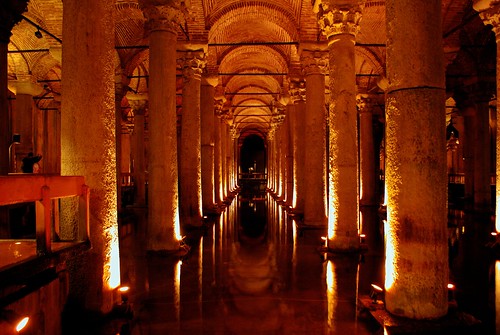Having left Moscow, but missing some of the people I left there (one in particular), I ran off to Istanbul for a bit. I mostly went to meet them, but also because I was tired of people saying "you haven't been to Istanbul? You have to go!" and of course because I am quite in love with history, and after having read so much about the region and the Ottoman Empire, I didn't want to miss an opportunity to see some of these famous sites(Hagia Sophia, Topkapi Palace,the spectacular Cistern and the Hippodrome, now a small plaza, which was the center of the Nika Rebellion) firsthand.
In addition to a lovely first morning sitting on my balcony and watching the seabirds dart about as the sun rose over the mighty Bosporus and its many ships, and a peaceful evening at a nargile (shisha) bar on a bridge above the water and spamming the two continents, there were quite a few spectacular sights.
Hagia Sophia was particularly interesting, not only for its own beauty, the architectural presence (Isidore of Miletus and Anthemius of Tralles have my profound respect), and clearly visible history, but because I was there with the Dangerous Russian (so called not because he is a dangerous person, but rather because he is dangerous to me), which gave the visit a very different perspective. To my liberal eyes, Hagia Sophia is currently in a good situation; first for Christians, then Muslims, she is now open to all. The DR thinks quite differently, however. He is a true (Orthodox) believer and was quite upset over the imposition of Islam over so holy a site. His argument was that Christians should not desecrate Moslem sites and Mosques, while Mehmet the Conqeuror should never have made Hagia Sophia a Mosque, and remaining Islamic items, most notably the large calligraphic shields a desecration that should be removed out of respect to the Church.
Some of the Byzantine mosaics are in very poor repair as well, a situation exacerbated by the recent uncovering of many, which were beneath later Islamic plaster and decor. Exposed to the air, the grout crumbled and the mosaics imperiled. The Dangerous Russian was of the opinion that it might be deliberate, in order to eradicate Christian elements, an idea which I initially thought was a bit paranoid, but which I have since heard echoed in some calmer, more academic circles. Apparently the new, Islamic, government is making a few people nervous and whereas the elimination of rival religious or ethnic symbols is one of the first signs of impending conflict, the tragedy of the mosaics' loss (if they are not restored) is viewed by some as a sign that difficulties may be ahead. I'm not sure if I believe this, but it is an interesting perspective.
On a more secular front, also bought myself some highly secular Attatürk collectors' cards, each with a photo of Attatürk looking alternatively paternal, vigilant, visionary, caring, military, intelligent, hard working, etc and with an inspirational quite from the Great Man (alas, in Turkish only, which I don't speak, and which means that I must slowly accumulate translations from my few Turkish-speaking acquaintances), on the back.
It was also interesting to see how many traces of the Nika Rebellion remain. Such a short incident, almost 1500 years ago, and it is still visible. Which makes me wonder what other stories are still there, if one only knew what to look for.
 The Cistern. Originally built to hold water for the city, it is still elegant and graceful, an ambiance only enhanced by the cool temperature, alternatively ornamental and funky-looking fishes and the slow, soft Turkish music echoing throughout.
The Cistern. Originally built to hold water for the city, it is still elegant and graceful, an ambiance only enhanced by the cool temperature, alternatively ornamental and funky-looking fishes and the slow, soft Turkish music echoing throughout.

The second, sideways, Medusa head/column base




No comments:
Post a Comment